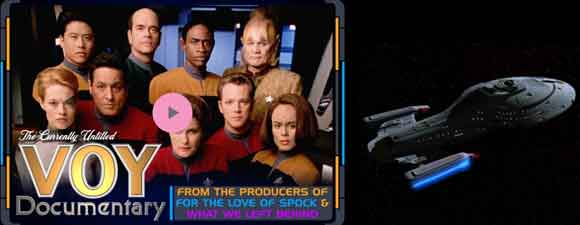Retro Review: Scientific Method
7 min read
scientificmethodbanner
Only Seven of Nine can perceive aliens who conduct painful, dangerous experiments on the crew.
Plot Summary: Paris sneaks off duty with flowers for Torres to make up for having missed a date the night before, but they both feel paranoid about kissing in public areas. In fact, unseen aliens are watching them and the rest of the crew, many of whom have disturbing symptoms: Janeway has excruciating headaches, Chakotay experiences premature aging, and Neelix develops the sweat glands and visual problems of the Myleans from whom he is descended. When Torres helps the Doctor scan Chakotay’s DNA, they find that it has been altered with an alien code emitting a signal. Abruptly, the EMH program begins to disappear. Torres tries to help transfer him to sickbay but is afflicted by a condition that prevents her lungs from processing oxygen. Paris stabilizes her, but believes the Doctor’s program has been lost. Yet Seven of Nine receives a private signal directly in her Borg audio implants from the Doctor, who is hiding on the holodeck. He tells her of the evidence he found that the crew’s DNA was purposefully altered and suggests that Seven scan the transmission frequency that Torres discovered just before the engineer was incapacitated. Seven allows the Doctor to alter her optical implant and suddenly can see dozens of aliens, out of sync with the crew yet able to perform experiments on them. Many officers have needles or brain implants visible, and Seven herself is probed by one of the aliens. The Doctor believes that Seven can use the ship’s EPS conduits to shock both aliens and crew, incapacitating the invaders, but when Tuvok prevents Seven from making the necessary alterations, Seven shoots one of the aliens with a modified phaser to make the invader visible. In the brig, Janeway questions the alien and learns that the invaders are using the crew as subjects for their own medical benefit. Because one crewmember has died and many lives remain at risk, Janeway flies the ship between binary pulsars, scaring the aliens into departing and destroying one of their vessels. Voyager survives the risky maneuver, and Paris and Torres finally have their date.
Analysis: Much to my surprise, I know several people who really like “Scientific Method” – or, to be precise, they like Janeway in a towel and the Doctor in tights. Given all the attention on Seven of Nine’s catsuits during this season, I can’t really fault anyone for objectifying any other crewmember, but if you’re a fan of science fiction or even just of Star Trek, you’ve seen this episode before. Repeatedly. It’s the same one-line pitch as “The Empath” (TOS), “Where Silence Has Lease” (TNG), and “Faces” (VOY), in which aliens perform horrible experiments on crewmembers in the name of progress. It features an unseen alien who manipulates everyone on the crew, like in “Day of the Dove” (TOS), “Schisms” (TNG), “Dramatis Personae” (DS9), and “Persistence of Vision” (VOY). The solution to the problem – having a crewmember with special abilities uncover and reveal the threat, as previous crews would have done with a VISOR, an empath’s intuition, an android’s perceptions, or a sign from the Prophets that only he can see – looks familiar, too. If you’ve always wanted to see an ex-Borg demonstrate that she can be Spock, Data, LaForge, Troi, Sisko, and Odo all in one, and you have a high tolerance for gratuitous crew suffering, you might love “Scientific Method” – otherwise, apart from the towel and some of the fakest-looking kissing in television history from Paris and Torres (with no tongue, as the alien x-ray shows us), the episode contributes nothing to the series, the franchise, or the genre, not even an innovative desperate solution since flying into a star was the last act of a desperate Denevan in “Operation: Annihilate” (TOS).
People have accused me of not being fair to Voyager starting in the fourth season because I hated Seven of Nine’s skin-tight costume, yet Seven’s costume isn’t even on my list of the top ten things wrong with the fourth season as epitomized by “Scientific Method” – which, to be fair, makes decent use of its bottle-show sets and lighting, and I appreciate the performances, particularly Mulgrew’s put-upon captain and Seven’s stoic investigator. But the script isn’t creative enough to allow for such memorable images as “Phantasms” (TNG) with its cellular peptide cake with mint frosting. As with that other recent horror show, “Revulsion,” the story plays its hand prematurely, showing us in the first moments that there’s unexplained evil at work and not merely bad choices on the part of the crew. Nothing as awful as the Doctor’s dismissal of Dejaren’s possible sexual abuse happens here, but without the flashes of color reversal, we might not even realize we’re supposed to think anyone is acting unnaturally, because the first time Paris and Torres kissed for real, it was in a public area and they were interrupted by the Doctor. Plus Janeway’s been pinch-faced, angry, isolated, and rude to crewmembers since “Scorpion.” As Paris says at the end of the episodes, maybe alien hormone interference made him and Torres pounce on each other like wild bunnies in engineering or maybe they just didn’t feel like behaving, and maybe alien dopamine bursts turned Janeway into a lonely shrew but maybe it’s a combination of too many hours with only holograms for company and getting backrubs these days from the Doctor in her quarters instead of from Chakotay on New Earth. I’m not sure whether to laugh or roll my eyes when she announces to Tuvok that crewmembers are spending more time on the holodeck than on duty, then promptly announces that she wants to take a vacation there.
I hope that crewmembers are spending more hours at leisure than at work – except during emergencies and archaic punishments, I’ve never heard of a naval watch lasting a full day, so I assume Starfleet’s are similar among humanoid species who need sleep and food – but the only person we’ve seen spending a disproportionate amount of time on the holodeck is Janeway herself. It is fun to see her gamble that the aliens will fear their own success and try to flee before she gets everyone killed, her crew and theirs alike – I don’t blame the captain a bit for concluding she’s better off taking the big risk than letting these aliens continue to torture her people in the name of their science. She’s tired, and in pain, and doesn’t want to sound like she’s open to any sort of negotiation, the same way she threatened the Vidiians with the deadliest of force. But she’s a scientist, someone who even in pain might want to ask how the aliens can pass through the solid matter of crewmembers’ arms without drawing attention yet not fall through the floors. And we all deserve some sort of explanation for the Srivani, who are so irrelevant to Trek history that they aren’t even named in the episode. Is their planet, like that of the Vidiians, so decimated by illness that they’ve become desperate? Are they looking for a weapon against the Borg – probably not, since they don’t seem terribly interested in Seven – or some other species-destroying enemy? Clearly, they’re enormously advanced, like the similarly malevolent out-of-phase Devidians of “Time’s Arrow” – but they don’t appear to be looking for alien energy to harvest or indeed seeking any specific requirement. Yet something must have made them venture into space for the express purpose of performing such experiments on strangers…something other than plot contrivance.
The fact that Voyager’s crew is from far away from where they encounter one another doesn’t seem either to have attracted or concerned the aliens. You’d think Janeway would point it out, since she might run into Srivani in twenty other places on her way back to Earth. You’d also think she’d want to find out exactly what they’re looking for, whether there’s a way to stop them from doing it to other random passersby or at least to warn anyone encountered later on. Even in bad horror movies there’s usually some nominal reason for the mayhem – revenge, psychosis, hatred of mean girls, desperation for blood to suck. These motive-free aliens apparently reflect either some writer’s nightmare of socialized health care or some writer’s deep distrust of medical experiments, both of which seem antithetical to Star Trek’s respect for science and scientists as well as for collaborative research. If we’re supposed to develop moral qualms concerning human experiments with animals, the parallels need to be more explicit and more relatable. As with Dejaren, we must believe we have something in common with the villains, not simply cheer for their demise. Except from a perverse desire to see what nasty things will happen next, “Scientific Method” contributes nothing to the show or the genre. Meanwhile, Voyager continues to glorify one individual, which may be necessary for a time in contrast to the hive mind of the Borg, but it’s disruptive of the sense of teamwork and camaraderie the series spent several seasons building. Seven may be a brilliant technician, but is it necessary for her to gain all the brains and control that Janeway and Torres have lost? It’s not Janeway’s fault if evil aliens disrupt her dopamine levels, but yet again she nearly loses full control of her ship, something no colorful da Vinci holoprogram is going to be able to fix. Voyager’s mission to find Tuvok and the Maquis was supposed to be brief, as its passengers set sail that day for a three-hour tour – excuse me, a few weeks – but it’s a perfect demonstration of why no Starfleet vessel operating in deep space should launch without a counselor on board.






